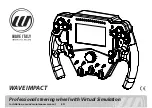
70
CTI Janus Programmable Automation Controller IOG
Subnet Mask
Used alone, the designation of network classes proved to be inflexible. Assigning large numbers of devices to the
same network is impractical considering performance, topology, and security constraints. The Subnet Mask,
sometimes called the Network Mask, provides a flexible means of designating the Network ID portion and Host ID
portions of the network address. In modern TCP/IP implementations, the network class is largely ignored, except
for setting the default subnet mask
The subnet mask is a collection of 32 bits that distinguish the network ID portion of the IP address from the host
ID. Subnet masks are implemented by assigning 1's to bits that belong to the network ID and 0's to the bits that
belong to the host ID. To represent the mask, the 32-bit value is converted to dotted decimal notation or CIDR
(Classless Inter-Domain Routing) notation, a commonly used alternate. The CIDR notation counts the number of
bits in Network ID portion of the address (bits that are set to 1). The count is preceded by a slash. See the example
below.
Bits for Network Mask
Dotted Decimal Format
CIDR Format
11111111 00000000
00000000
00000000
255.0.0.0
/8
11111111 11111111
11110000
00000000
255.255.240.0
/20
11111111 11111111
11111111
00000000
255.255.255.0
/24
For example: when the IP address is 128.54.177.97 and the network mask is 255.255.255.0, the Network ID is
128.54.177 and the Host ID is 97. When using the CIDR format, the network mask is appended to the IP address.
Thus the IP address and subnet mask shown above would be represented as 128.54.177.97 /24.
NOTE
The binary representation of a Network Mask must be a single continuous block 1’s followed by a contiguous block of
zeroes. When entering the Network Mask in dotted decimal notation, you must ensure that this requirement is
maintained. For example, a network mask of 255.247.0.0 is not valid because the binary equivalent
(11111111111101110000000000000000) violates this rule.
The Network Mask must allow at least two bits of host address. In addition, a network mask which causes the
derived host ID to be 0 or a broadcast address (all Host ID bits set to 1) should not be used.













































